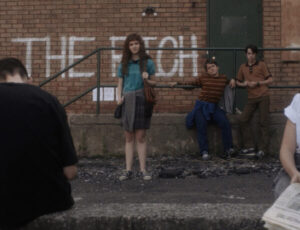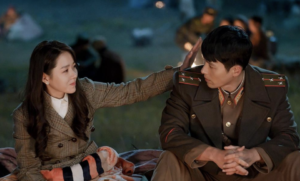
There are few images that dominate Western perspectives of the Middle East more so than the burqa. Seen by many in the West as an instrument of women’s oppression, there have been many movements to ban it in European countries such as France and Italy. However, the history of the garment and the perspectives of Afghan people who are most familiar with it are not always brought in to view. In
Story of Burqa: Case of a Confused Afghan, Brishkay Ahmed, an Afghan-Canadian filmmaker travels to Afghanistan with the purpose of unraveling the history of the garment and gauge the opinions of those in the country.
During Ahmed’s journey, she interviews many people and finds varying perspectives from those who support or oppose it regarding where the burqa came from. Nearly all speakers point out that the burqa is not a traditional Islamic garment, although its use was enforced during the rule of the Taliban under the guise of religious purpose. There are many theories regarding where it came from. Some claim the burqa came from India, where it was originally used to disguise the identity of women belonging to the king’s harem. Others say it was a fashion symbol of the Afghan middle class women. Still others blame the prevalence of the burqa on other countries attempts to control the Afghan population for political means. The British is pointed out as a potential culprit who introduced it as a means to quell the population. Others point to Iranian influence, who in hopes of taming their own women, propagated the spread of the burqa in Afghanistan. The idea being that by restricting the freedoms of a neighbouring country, then hopefully their own population would be less inclined to rebel. It all paints a very interesting picture of who has a stake in the success of the burqa. Even China, who now mass-produces them for the Afghan market, has economic interests in its survival. No matter the real history, the stories generally point to the same end. Ahmed observes that the burqa has long been used to the benefit of those in power, and women consistently emerge as the losing party.
Although the film digs up some fascinating history, its direction at times is a little confusing. Rather than focus and dig deeper into one area (ie. the history of the burqa), Ahmed continually veers off and laments how difficult and uncomfortable the burqa is to wear. While one would assume this point is obvious, and would perhaps only touch on it once, we are treated to 3 separate ‘fish out of water’ circumstances of women dawning the burqa. The first two instances are Ahmed, testing it in both Vancouver and Afghanistan, noting the scratchy, hot fabric and impeded ability to see. The third time, Ahmed asks a North American woman to try it on and give her opinion. Ahmed asks her if she thinks the burqa is beautiful or awkward and the woman provides her with a kind, politically correct response, that while she respects those who choose to wear it, it isn’t for her. I found this choice very odd, and not helpful for the film as a whole. We can already assume to know what this woman’s response will be. Why present a Western woman’s 30 second experience with a burqa, rather than focusing the lens on women who have worn it for a greater part of their lives? What I found more distressing was that this woman was 1 of only 4 who were given the opportunity to speak about the burqa. While presenting us with a menagerie of men offering their perspectives and expertise, we are only granted a very limited female perspective. Only 1 of these women, a British curator of a textile research center, provides any insight into the political and social history of the burqa. The other two women, both Afghans, are limited by Ahmed’s questioning and thus focus only on its comfort and fashionability. We never find out if they have any deeper opinions regarding its societal impact or how it has affected them personally.
Although this film was an ambitious undertaking, and brought forth a wealth of information, I found myself a little disappointed in Ahmed’s limited sources of information. A stronger and more diverse female presence in front of the camera would have benefitted her analysis.
The world premiere of the film is part of the
DOXA Documentary Film Festival’s
Making Waves Spotlight on Canadian Women in Documentary and takes place
Thursday May 10, 7pm at the
Empire Granville 7 Cinemas. Singer
Mozhdah Jamalzadah, known as “the Oprah of Afghanistan,” will perform a song after the screening.
Photo courtesy of Brishkay Ahmed
 There are few images that dominate Western perspectives of the Middle East more so than the burqa. Seen by many in the West as an instrument of women’s oppression, there have been many movements to ban it in European countries such as France and Italy. However, the history of the garment and the perspectives of Afghan people who are most familiar with it are not always brought in to view. In Story of Burqa: Case of a Confused Afghan, Brishkay Ahmed, an Afghan-Canadian filmmaker travels to Afghanistan with the purpose of unraveling the history of the garment and gauge the opinions of those in the country.
During Ahmed’s journey, she interviews many people and finds varying perspectives from those who support or oppose it regarding where the burqa came from. Nearly all speakers point out that the burqa is not a traditional Islamic garment, although its use was enforced during the rule of the Taliban under the guise of religious purpose. There are many theories regarding where it came from. Some claim the burqa came from India, where it was originally used to disguise the identity of women belonging to the king’s harem. Others say it was a fashion symbol of the Afghan middle class women. Still others blame the prevalence of the burqa on other countries attempts to control the Afghan population for political means. The British is pointed out as a potential culprit who introduced it as a means to quell the population. Others point to Iranian influence, who in hopes of taming their own women, propagated the spread of the burqa in Afghanistan. The idea being that by restricting the freedoms of a neighbouring country, then hopefully their own population would be less inclined to rebel. It all paints a very interesting picture of who has a stake in the success of the burqa. Even China, who now mass-produces them for the Afghan market, has economic interests in its survival. No matter the real history, the stories generally point to the same end. Ahmed observes that the burqa has long been used to the benefit of those in power, and women consistently emerge as the losing party.
Although the film digs up some fascinating history, its direction at times is a little confusing. Rather than focus and dig deeper into one area (ie. the history of the burqa), Ahmed continually veers off and laments how difficult and uncomfortable the burqa is to wear. While one would assume this point is obvious, and would perhaps only touch on it once, we are treated to 3 separate ‘fish out of water’ circumstances of women dawning the burqa. The first two instances are Ahmed, testing it in both Vancouver and Afghanistan, noting the scratchy, hot fabric and impeded ability to see. The third time, Ahmed asks a North American woman to try it on and give her opinion. Ahmed asks her if she thinks the burqa is beautiful or awkward and the woman provides her with a kind, politically correct response, that while she respects those who choose to wear it, it isn’t for her. I found this choice very odd, and not helpful for the film as a whole. We can already assume to know what this woman’s response will be. Why present a Western woman’s 30 second experience with a burqa, rather than focusing the lens on women who have worn it for a greater part of their lives? What I found more distressing was that this woman was 1 of only 4 who were given the opportunity to speak about the burqa. While presenting us with a menagerie of men offering their perspectives and expertise, we are only granted a very limited female perspective. Only 1 of these women, a British curator of a textile research center, provides any insight into the political and social history of the burqa. The other two women, both Afghans, are limited by Ahmed’s questioning and thus focus only on its comfort and fashionability. We never find out if they have any deeper opinions regarding its societal impact or how it has affected them personally.
Although this film was an ambitious undertaking, and brought forth a wealth of information, I found myself a little disappointed in Ahmed’s limited sources of information. A stronger and more diverse female presence in front of the camera would have benefitted her analysis.
The world premiere of the film is part of the DOXA Documentary Film Festival’s Making Waves Spotlight on Canadian Women in Documentary and takes place Thursday May 10, 7pm at the Empire Granville 7 Cinemas. Singer Mozhdah Jamalzadah, known as “the Oprah of Afghanistan,” will perform a song after the screening.
Photo courtesy of Brishkay Ahmed
There are few images that dominate Western perspectives of the Middle East more so than the burqa. Seen by many in the West as an instrument of women’s oppression, there have been many movements to ban it in European countries such as France and Italy. However, the history of the garment and the perspectives of Afghan people who are most familiar with it are not always brought in to view. In Story of Burqa: Case of a Confused Afghan, Brishkay Ahmed, an Afghan-Canadian filmmaker travels to Afghanistan with the purpose of unraveling the history of the garment and gauge the opinions of those in the country.
During Ahmed’s journey, she interviews many people and finds varying perspectives from those who support or oppose it regarding where the burqa came from. Nearly all speakers point out that the burqa is not a traditional Islamic garment, although its use was enforced during the rule of the Taliban under the guise of religious purpose. There are many theories regarding where it came from. Some claim the burqa came from India, where it was originally used to disguise the identity of women belonging to the king’s harem. Others say it was a fashion symbol of the Afghan middle class women. Still others blame the prevalence of the burqa on other countries attempts to control the Afghan population for political means. The British is pointed out as a potential culprit who introduced it as a means to quell the population. Others point to Iranian influence, who in hopes of taming their own women, propagated the spread of the burqa in Afghanistan. The idea being that by restricting the freedoms of a neighbouring country, then hopefully their own population would be less inclined to rebel. It all paints a very interesting picture of who has a stake in the success of the burqa. Even China, who now mass-produces them for the Afghan market, has economic interests in its survival. No matter the real history, the stories generally point to the same end. Ahmed observes that the burqa has long been used to the benefit of those in power, and women consistently emerge as the losing party.
Although the film digs up some fascinating history, its direction at times is a little confusing. Rather than focus and dig deeper into one area (ie. the history of the burqa), Ahmed continually veers off and laments how difficult and uncomfortable the burqa is to wear. While one would assume this point is obvious, and would perhaps only touch on it once, we are treated to 3 separate ‘fish out of water’ circumstances of women dawning the burqa. The first two instances are Ahmed, testing it in both Vancouver and Afghanistan, noting the scratchy, hot fabric and impeded ability to see. The third time, Ahmed asks a North American woman to try it on and give her opinion. Ahmed asks her if she thinks the burqa is beautiful or awkward and the woman provides her with a kind, politically correct response, that while she respects those who choose to wear it, it isn’t for her. I found this choice very odd, and not helpful for the film as a whole. We can already assume to know what this woman’s response will be. Why present a Western woman’s 30 second experience with a burqa, rather than focusing the lens on women who have worn it for a greater part of their lives? What I found more distressing was that this woman was 1 of only 4 who were given the opportunity to speak about the burqa. While presenting us with a menagerie of men offering their perspectives and expertise, we are only granted a very limited female perspective. Only 1 of these women, a British curator of a textile research center, provides any insight into the political and social history of the burqa. The other two women, both Afghans, are limited by Ahmed’s questioning and thus focus only on its comfort and fashionability. We never find out if they have any deeper opinions regarding its societal impact or how it has affected them personally.
Although this film was an ambitious undertaking, and brought forth a wealth of information, I found myself a little disappointed in Ahmed’s limited sources of information. A stronger and more diverse female presence in front of the camera would have benefitted her analysis.
The world premiere of the film is part of the DOXA Documentary Film Festival’s Making Waves Spotlight on Canadian Women in Documentary and takes place Thursday May 10, 7pm at the Empire Granville 7 Cinemas. Singer Mozhdah Jamalzadah, known as “the Oprah of Afghanistan,” will perform a song after the screening.
Photo courtesy of Brishkay Ahmed 







